先决条件:LCA基础知识,按等级和路径压缩的不相交集并集
我们得到了一棵树(可以扩展为DAG),并且有许多形式为LCA(u,v)的查询,即找到节点’u’和’v’的LCA。
我们可以使用RMQ在O(N + QlogN)的时间内执行这些查询,其中O(N)用于预处理,O(log N)用于回答查询,其中
N =节点数,并且
Q =要回答的查询数。
我们可以做得更好吗?我们可以在线性(几乎)时间内做吗?是的。
本文介绍了一种离线算法,该算法可以在大约O(N + Q)的时间内执行这些查询。尽管这不是完全线性的,但时间复杂度分析中涉及逆阿克曼函数。有关逆阿克曼函数的更多详细信息,请参见此。综上所述,对于任何可以物理逆写的输入大小值,我们可以说逆阿克曼函数保持小于4。因此,我们认为这几乎是线性的。
我们考虑如下所示的输入树。我们将根据以下说明对树进行预处理并填充两个数组: child []和sibling []-
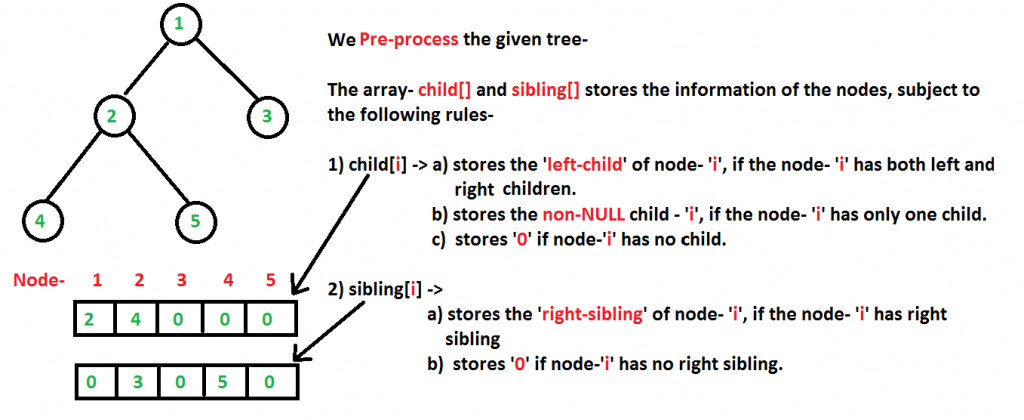
让我们想处理这些查询-LCA (5,4),LCA(1,3),LCA(2,3)
现在,经过预处理后,我们从树的根(此处为节点“ 1”)开始执行LCA遍历。但是在LCA遍历之前,我们使用WHITE为所有节点着色。在整个LCA遍历过程中,我们使用三个不相交的集合联合函数-makeSet(),findSet(),unionSet()。
这些功能使用等级和路径压缩并集技术来改善运行时间。在LCA遍历期间,我们的查询将得到处理和输出(以随机顺序)。在整个树的LCA遍历之后,所有节点的颜色都变为BLACK 。
Tarjan离线LCA算法从CLRS,第21-3节,第584页,第二版/第三版开始。
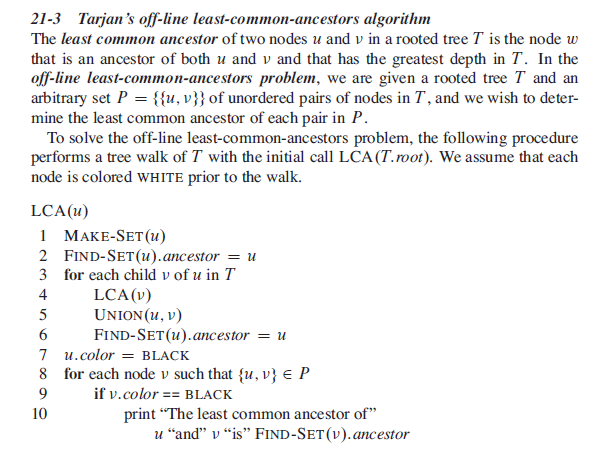
注意:可能无法按原始顺序处理查询。我们可以轻松地修改流程并根据输入顺序对其进行排序。
下面的图片清楚地描述了所有正在发生的步骤。红色箭头显示了递归函数LCA()的行进方向。
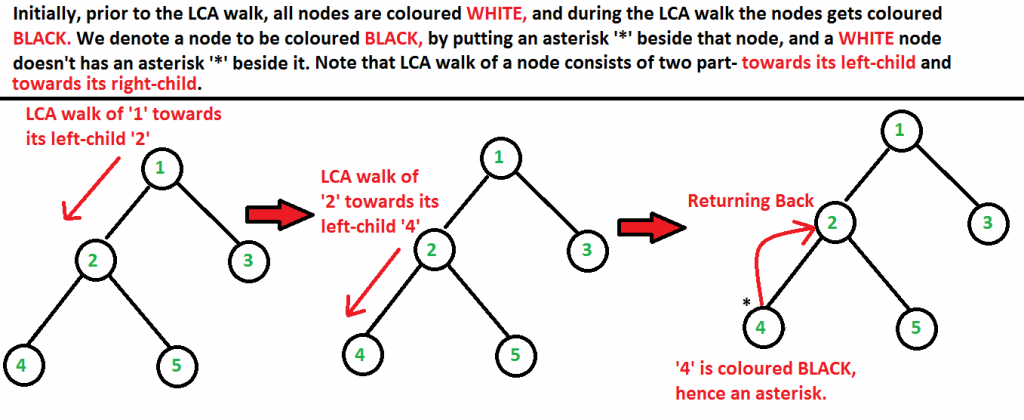
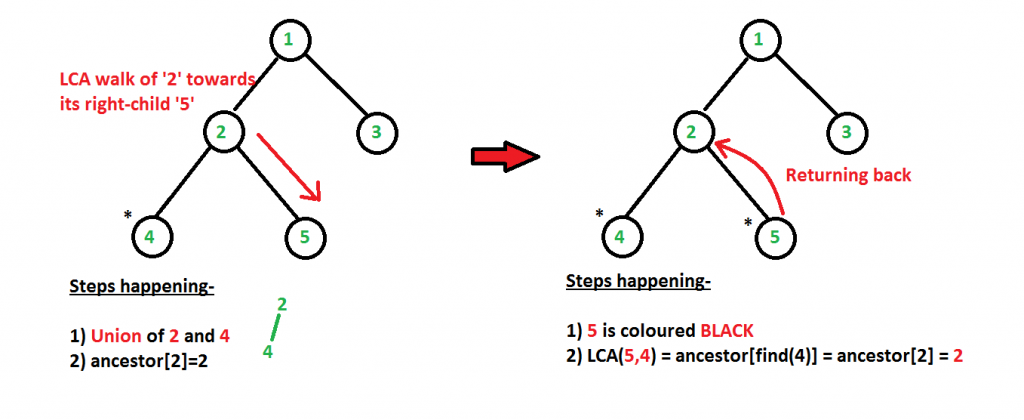
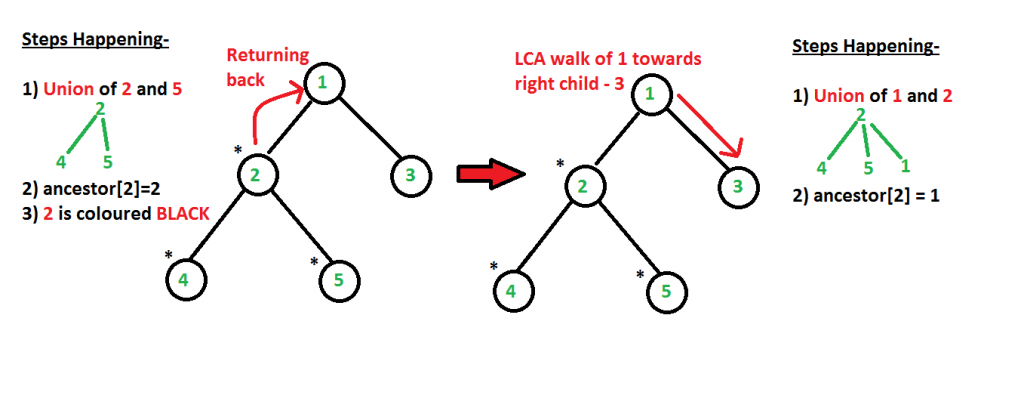
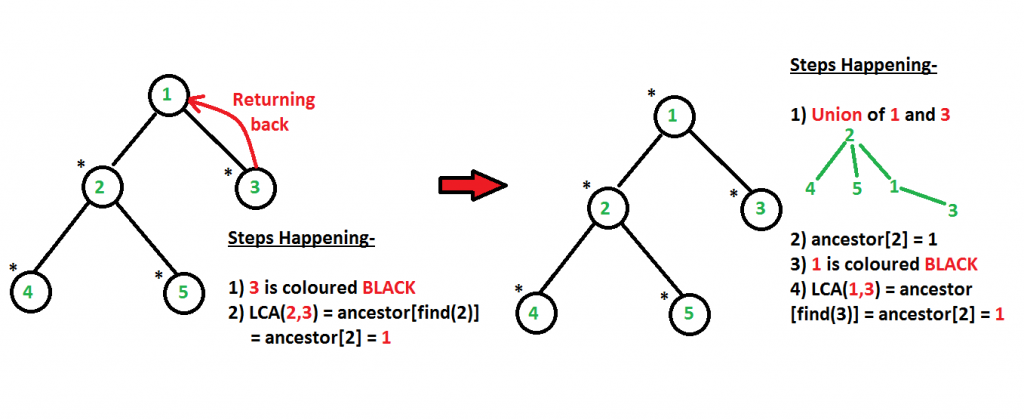
从上面的图片中我们可以清楚地看到,查询按以下顺序处理:LCA(5,4),LCA(2,3),LCA(1,3),其输入顺序与输入顺序不同(LCA(5,4),LCA(1,3),LCA(2,3))。
下面是上述方法的实现:
C++
// A C++ Program to implement Tarjan Offline LCA Algorithm
#include
#define V 5 // number of nodes in input tree
#define WHITE 1 // COLOUR 'WHITE' is assigned value 1
#define BLACK 2 // COLOUR 'BLACK' is assigned value 2
/* A binary tree node has data, pointer to left child
and a pointer to right child */
struct Node
{
int data;
Node* left, *right;
};
/*
subset[i].parent-->Holds the parent of node-'i'
subset[i].rank-->Holds the rank of node-'i'
subset[i].ancestor-->Holds the LCA queries answers
subset[i].child-->Holds one of the child of node-'i'
if present, else -'0'
subset[i].sibling-->Holds the right-sibling of node-'i'
if present, else -'0'
subset[i].color-->Holds the colour of node-'i'
*/
struct subset
{
int parent, rank, ancestor, child, sibling, color;
};
// Structure to represent a query
// A query consists of (L,R) and we will process the
// queries offline a/c to Tarjan's oflline LCA algorithm
struct Query
{
int L, R;
};
/* Helper function that allocates a new node with the
given data and NULL left and right pointers. */
Node* newNode(int data)
{
Node* node = new Node;
node->data = data;
node->left = node->right = NULL;
return(node);
}
//A utility function to make set
void makeSet(struct subset subsets[], int i)
{
if (i < 1 || i > V)
return;
subsets[i].color = WHITE;
subsets[i].parent = i;
subsets[i].rank = 0;
return;
}
// A utility function to find set of an element i
// (uses path compression technique)
int findSet(struct subset subsets[], int i)
{
// find root and make root as parent of i (path compression)
if (subsets[i].parent != i)
subsets[i].parent = findSet (subsets, subsets[i].parent);
return subsets[i].parent;
}
// A function that does union of two sets of x and y
// (uses union by rank)
void unionSet(struct subset subsets[], int x, int y)
{
int xroot = findSet (subsets, x);
int yroot = findSet (subsets, y);
// Attach smaller rank tree under root of high rank tree
// (Union by Rank)
if (subsets[xroot].rank < subsets[yroot].rank)
subsets[xroot].parent = yroot;
else if (subsets[xroot].rank > subsets[yroot].rank)
subsets[yroot].parent = xroot;
// If ranks are same, then make one as root and increment
// its rank by one
else
{
subsets[yroot].parent = xroot;
(subsets[xroot].rank)++;
}
}
// The main function that prints LCAs. u is root's data.
// m is size of q[]
void lcaWalk(int u, struct Query q[], int m,
struct subset subsets[])
{
// Make Sets
makeSet(subsets, u);
// Initially, each node's ancestor is the node
// itself.
subsets[findSet(subsets, u)].ancestor = u;
int child = subsets[u].child;
// This while loop doesn't run for more than 2 times
// as there can be at max. two children of a node
while (child != 0)
{
lcaWalk(child, q, m, subsets);
unionSet (subsets, u, child);
subsets[findSet(subsets, u)].ancestor = u;
child = subsets[child].sibling;
}
subsets[u].color = BLACK;
for (int i = 0; i < m; i++)
{
if (q[i].L == u)
{
if (subsets[q[i].R].color == BLACK)
{
printf("LCA(%d %d) -> %d\n",
q[i].L,
q[i].R,
subsets[findSet(subsets,q[i].R)].ancestor);
}
}
else if (q[i].R == u)
{
if (subsets[q[i].L].color == BLACK)
{
printf("LCA(%d %d) -> %d\n",
q[i].L,
q[i].R,
subsets[findSet(subsets,q[i].L)].ancestor);
}
}
}
return;
}
// This is basically an inorder traversal and
// we preprocess the arrays-> child[]
// and sibling[] in "struct subset" with
// the tree structure using this function.
void preprocess(Node * node, struct subset subsets[])
{
if (node == NULL)
return;
// Recur on left child
preprocess(node->left, subsets);
if (node->left != NULL&&node->right != NULL)
{
/* Note that the below two lines can also be this-
subsets[node->data].child = node->right->data;
subsets[node->right->data].sibling =
node->left->data;
This is because if both left and right children of
node-'i' are present then we can store any of them
in subsets[i].child and correspondingly its sibling*/
subsets[node->data].child = node->left->data;
subsets[node->left->data].sibling =
node->right->data;
}
else if ((node->left != NULL && node->right == NULL)
|| (node->left == NULL && node->right != NULL))
{
if(node->left != NULL && node->right == NULL)
subsets[node->data].child = node->left->data;
else
subsets[node->data].child = node->right->data;
}
//Recur on right child
preprocess (node->right, subsets);
}
// A function to initialise prior to pre-processing and
// LCA walk
void initialise(struct subset subsets[])
{
// Initialising the structure with 0's
memset(subsets, 0, (V+1) * sizeof(struct subset));
// We colour all nodes WHITE before LCA Walk.
for (int i=1; i<=V; i++)
subsets[i].color=WHITE;
return;
}
// Prints LCAs for given queries q[0..m-1] in a tree
// with given root
void printLCAs(Node *root, Query q[], int m)
{
// Allocate memory for V subsets and nodes
struct subset * subsets = new subset[V+1];
// Creates subsets and colors them WHITE
initialise(subsets);
// Preprocess the tree
preprocess(root, subsets);
// Perform a tree walk to process the LCA queries
// offline
lcaWalk(root->data , q, m, subsets);
}
// Driver program to test above functions
int main()
{
/*
We construct a binary tree :-
1
/ \
2 3
/ \
4 5 */
Node *root = newNode(1);
root->left = newNode(2);
root->right = newNode(3);
root->left->left = newNode(4);
root->left->right = newNode(5);
// LCA Queries to answer
Query q[] = {{5, 4}, {1, 3}, {2, 3}};
int m = sizeof(q)/sizeof(q[0]);
printLCAs(root, q, m);
return 0;
} Java
// A Java Program to implement Tarjan Offline LCA Algorithm
import java.util.Arrays;
class GFG
{
static final int V = 5; // number of nodes in input tree
static final int WHITE = 1; // COLOUR 'WHITE' is assigned value 1
static final int BLACK = 2; // COLOUR 'BLACK' is assigned value 2
/* A binary tree node has data, pointer to left child
and a pointer to right child */
static class Node
{
int data;
Node left, right;
};
/*
subset[i].parent-.Holds the parent of node-'i'
subset[i].rank-.Holds the rank of node-'i'
subset[i].ancestor-.Holds the LCA queries answers
subset[i].child-.Holds one of the child of node-'i'
if present, else -'0'
subset[i].sibling-.Holds the right-sibling of node-'i'
if present, else -'0'
subset[i].color-.Holds the colour of node-'i'
*/
static class subset
{
int parent;
int rank;
int ancestor;
int child;
int sibling;
int color;
};
// Structure to represent a query
// A query consists of (L,R) and we will process the
// queries offline a/c to Tarjan's oflline LCA algorithm
static class Query
{
int L, R;
Query(int L, int R)
{
this.L = L;
this.R = R;
}
};
/* Helper function that allocates a new node with the
given data and null left and right pointers. */
static Node newNode(int data)
{
Node node = new Node();
node.data = data;
node.left = node.right = null;
return(node);
}
// A utility function to make set
static void makeSet(subset subsets[], int i)
{
if (i < 1 || i > V)
return;
subsets[i].color = WHITE;
subsets[i].parent = i;
subsets[i].rank = 0;
return;
}
// A utility function to find set of an element i
// (uses path compression technique)
static int findSet(subset subsets[], int i)
{
// find root and make root as parent of i (path compression)
if (subsets[i].parent != i)
subsets[i].parent = findSet (subsets, subsets[i].parent);
return subsets[i].parent;
}
// A function that does union of two sets of x and y
// (uses union by rank)
static void unionSet(subset subsets[], int x, int y)
{
int xroot = findSet (subsets, x);
int yroot = findSet (subsets, y);
// Attach smaller rank tree under root of high rank tree
// (Union by Rank)
if (subsets[xroot].rank < subsets[yroot].rank)
subsets[xroot].parent = yroot;
else if (subsets[xroot].rank > subsets[yroot].rank)
subsets[yroot].parent = xroot;
// If ranks are same, then make one as root and increment
// its rank by one
else
{
subsets[yroot].parent = xroot;
(subsets[xroot].rank)++;
}
}
// The main function that prints LCAs. u is root's data.
// m is size of q[]
static void lcaWalk(int u, Query q[], int m,
subset subsets[])
{
// Make Sets
makeSet(subsets, u);
// Initially, each node's ancestor is the node
// itself.
subsets[findSet(subsets, u)].ancestor = u;
int child = subsets[u].child;
// This while loop doesn't run for more than 2 times
// as there can be at max. two children of a node
while (child != 0)
{
lcaWalk(child, q, m, subsets);
unionSet (subsets, u, child);
subsets[findSet(subsets, u)].ancestor = u;
child = subsets[child].sibling;
}
subsets[u].color = BLACK;
for (int i = 0; i < m; i++)
{
if (q[i].L == u)
{
if (subsets[q[i].R].color == BLACK)
{
System.out.printf("LCA(%d %d)->%d\n",
q[i].L,
q[i].R,
subsets[findSet(subsets,q[i].R)].ancestor);
}
}
else if (q[i].R == u)
{
if (subsets[q[i].L].color == BLACK)
{
System.out.printf("LCA(%d %d)->%d\n",
q[i].L,
q[i].R,
subsets[findSet(subsets,q[i].L)].ancestor);
}
}
}
return;
}
// This is basically an inorder traversal and
// we preprocess the arrays. child[]
// and sibling[] in "subset" with
// the tree structure using this function.
static void preprocess(Node node, subset subsets[])
{
if (node == null)
return;
// Recur on left child
preprocess(node.left, subsets);
if (node.left != null && node.right != null)
{
/* Note that the below two lines can also be this-
subsets[node.data].child = node.right.data;
subsets[node.right.data].sibling =
node.left.data;
This is because if both left and right children of
node-'i' are present then we can store any of them
in subsets[i].child and correspondingly its sibling*/
subsets[node.data].child = node.left.data;
subsets[node.left.data].sibling =
node.right.data;
}
else if ((node.left != null && node.right == null)
|| (node.left == null && node.right != null))
{
if(node.left != null && node.right == null)
subsets[node.data].child = node.left.data;
else
subsets[node.data].child = node.right.data;
}
// Recur on right child
preprocess (node.right, subsets);
}
// A function to initialise prior to pre-processing and
// LCA walk
static void initialise(subset subsets[])
{
// We colour all nodes WHITE before LCA Walk.
for (int i = 1; i < subsets.length; i++)
{
subsets[i] = new subset();
subsets[i].color = WHITE;
}
return;
}
// Prints LCAs for given queries q[0..m-1] in a tree
// with given root
static void printLCAs(Node root, Query q[], int m)
{
// Allocate memory for V subsets and nodes
subset []subsets = new subset[V + 1];
// Creates subsets and colors them WHITE
initialise(subsets);
// Preprocess the tree
preprocess(root, subsets);
// Perform a tree walk to process the LCA queries
// offline
lcaWalk(root.data , q, m, subsets);
}
// Driver code
public static void main(String[] args)
{
/*
We cona binary tree :-
1
/ \
2 3
/ \
4 5 */
Node root = newNode(1);
root.left = newNode(2);
root.right = newNode(3);
root.left.left = newNode(4);
root.left.right = newNode(5);
// LCA Queries to answer
Query q[] = new Query[3];
q[0] = new Query(5, 4);
q[1] = new Query(1, 3);
q[2] = new Query(2, 3);
int m = q.length;
printLCAs(root, q, m);
}
}
// This code is contributed by gauravrajput1Python3
# A Python3 program to implement Tarjan
# Offline LCA Algorithm
# Number of nodes in input tree
V = 5
# COLOUR 'WHITE' is assigned value 1
WHITE = 1
# COLOUR 'BLACK' is assigned value 2
BLACK = 2
# A binary tree node has data, pointer
# to left child and a pointer to right child
class Node:
def __init__(self):
self.data = 0
self.left = None
self.right = None
'''
subset[i].parent-.Holds the parent of node-'i'
subset[i].rank-.Holds the rank of node-'i'
subset[i].ancestor-.Holds the LCA queries answers
subset[i].child-.Holds one of the child of node-'i'
if present, else -'0'
subset[i].sibling-.Holds the right-sibling of node-'i'
if present, else -'0'
subset[i].color-.Holds the colour of node-'i'
'''
class subset:
def __init__(self):
self.parent = 0
self.rank = 0
self.ancestor = 0
self.child = 0
self.sibling = 0
self.color = 0
# Structure to represent a query
# A query consists of (L,R) and we
# will process the queries offline
# a/c to Tarjan's oflline LCA algorithm
class Query:
def __init__(self, L, R):
self.L = L
self.R = R
# Helper function that allocates a new node
# with the given data and None left and
# right pointers.
def newNode(data):
node = Node()
node.data = data
node.left = node.right = None
return (node)
# A utility function to make set
def makeSet(subsets, i):
if (i < 1 or i > V):
return
subsets[i].color = WHITE
subsets[i].parent = i
subsets[i].rank = 0
return
# A utility function to find set of an element i
# (uses path compression technique)
def findSet(subsets, i):
# Find root and make root as parent
# of i (path compression)
if (subsets[i].parent != i):
subsets[i].parent = findSet(subsets,
subsets[i].parent)
return subsets[i].parent
# A function that does union of two sets
# of x and y (uses union by rank)
def unionSet(subsets, x, y):
xroot = findSet(subsets, x)
yroot = findSet(subsets, y)
# Attach smaller rank tree under root of
# high rank tree (Union by Rank)
if (subsets[xroot].rank < subsets[yroot].rank):
subsets[xroot].parent = yroot
elif (subsets[xroot].rank > subsets[yroot].rank):
subsets[yroot].parent = xroot
# If ranks are same, then make one as root
# and increment its rank by one
else:
subsets[yroot].parent = xroot
(subsets[xroot].rank) += 1
# The main function that prints LCAs. u is
# root's data. m is size of q[]
def lcaWalk(u, q, m, subsets):
# Make Sets
makeSet(subsets, u)
# Initially, each node's ancestor is the node
# itself.
subsets[findSet(subsets, u)].ancestor = u
child = subsets[u].child
# This while loop doesn't run for more than 2 times
# as there can be at max. two children of a node
while (child != 0):
lcaWalk(child, q, m, subsets)
unionSet(subsets, u, child)
subsets[findSet(subsets, u)].ancestor = u
child = subsets[child].sibling
subsets[u].color = BLACK
for i in range(m):
if (q[i].L == u):
if (subsets[q[i].R].color == BLACK):
print("LCA(%d %d) -> %d" % (q[i].L, q[i].R,
subsets[findSet(subsets, q[i].R)].ancestor))
elif (q[i].R == u):
if (subsets[q[i].L].color == BLACK):
print("LCA(%d %d) -> %d" % (q[i].L, q[i].R,
subsets[findSet(subsets, q[i].L)].ancestor))
return
# This is basically an inorder traversal and
# we preprocess the arrays. child[]
# and sibling[] in "struct subset" with
# the tree structure using this function.
def preprocess(node, subsets):
if (node == None):
return
# Recur on left child
preprocess(node.left, subsets)
if (node.left != None and node.right != None):
''' Note that the below two lines can also be this-
subsets[node.data].child = node.right.data;
subsets[node.right.data].sibling =
node.left.data;
This is because if both left and right children of
node-'i' are present then we can store any of them
in subsets[i].child and correspondingly its sibling'''
subsets[node.data].child = node.left.data
subsets[node.left.data].sibling = node.right.data
elif ((node.left != None and node.right == None)
or (node.left == None and node.right != None)):
if (node.left != None and node.right == None):
subsets[node.data].child = node.left.data
else:
subsets[node.data].child = node.right.data
# Recur on right child
preprocess(node.right, subsets)
# A function to initialise prior to pre-processing and
# LCA walk
def initialise(subsets):
# Initialising the structure with 0's
# memset(subsets, 0, (V+1) * sizeof(struct subset));
# We colour all nodes WHITE before LCA Walk.
for i in range(1, V + 1):
subsets[i].color = WHITE
return
# Prints LCAs for given queries q[0..m-1] in a tree
# with given root
def printLCAs(root, q, m):
# Allocate memory for V subsets and nodes
subsets = [subset() for _ in range(V + 1)]
# Creates subsets and colors them WHITE
initialise(subsets)
# Preprocess the tree
preprocess(root, subsets)
# Perform a tree walk to process the LCA queries
# offline
lcaWalk(root.data, q, m, subsets)
# Driver code
if __name__ == "__main__":
'''
We construct a binary tree :-
1
/ \
2 3
/ \
4 5 '''
root = newNode(1)
root.left = newNode(2)
root.right = newNode(3)
root.left.left = newNode(4)
root.left.right = newNode(5)
# LCA Queries to answer
q = [Query(5, 4), Query(1, 3), Query(2, 3)]
m = len(q)
printLCAs(root, q, m)
# This code is contributed by sanjeev2552C#
// A C# Program to implement Tarjan Offline LCA Algorithm
using System;
public class GFG
{
static readonly int V = 5; // number of nodes in input tree
static readonly int WHITE = 1; // COLOUR 'WHITE' is assigned value 1
static readonly int BLACK = 2; // COLOUR 'BLACK' is assigned value 2
/* A binary tree node has data, pointer to left child
and a pointer to right child */
public
class Node
{
public
int data;
public
Node left, right;
};
/*
subset[i].parent-.Holds the parent of node-'i'
subset[i].rank-.Holds the rank of node-'i'
subset[i].ancestor-.Holds the LCA queries answers
subset[i].child-.Holds one of the child of node-'i'
if present, else -'0'
subset[i].sibling-.Holds the right-sibling of node-'i'
if present, else -'0'
subset[i].color-.Holds the colour of node-'i'
*/
public
class subset
{
public
int parent;
public
int rank;
public
int ancestor;
public
int child;
public
int sibling;
public
int color;
};
// Structure to represent a query
// A query consists of (L,R) and we will process the
// queries offline a/c to Tarjan's oflline LCA algorithm
public
class Query
{
public
int L, R;
public
Query(int L, int R)
{
this.L = L;
this.R = R;
}
};
/* Helper function that allocates a new node with the
given data and null left and right pointers. */
static Node newNode(int data)
{
Node node = new Node();
node.data = data;
node.left = node.right = null;
return(node);
}
// A utility function to make set
static void makeSet(subset []subsets, int i)
{
if (i < 1 || i > V)
return;
subsets[i].color = WHITE;
subsets[i].parent = i;
subsets[i].rank = 0;
return;
}
// A utility function to find set of an element i
// (uses path compression technique)
static int findSet(subset []subsets, int i)
{
// find root and make root as parent of i (path compression)
if (subsets[i].parent != i)
subsets[i].parent = findSet (subsets, subsets[i].parent);
return subsets[i].parent;
}
// A function that does union of two sets of x and y
// (uses union by rank)
static void unionSet(subset []subsets, int x, int y)
{
int xroot = findSet (subsets, x);
int yroot = findSet (subsets, y);
// Attach smaller rank tree under root of high rank tree
// (Union by Rank)
if (subsets[xroot].rank < subsets[yroot].rank)
subsets[xroot].parent = yroot;
else if (subsets[xroot].rank > subsets[yroot].rank)
subsets[yroot].parent = xroot;
// If ranks are same, then make one as root and increment
// its rank by one
else
{
subsets[yroot].parent = xroot;
(subsets[xroot].rank)++;
}
}
// The main function that prints LCAs. u is root's data.
// m is size of q[]
static void lcaWalk(int u, Query []q, int m,
subset []subsets)
{
// Make Sets
makeSet(subsets, u);
// Initially, each node's ancestor is the node
// itself.
subsets[findSet(subsets, u)].ancestor = u;
int child = subsets[u].child;
// This while loop doesn't run for more than 2 times
// as there can be at max. two children of a node
while (child != 0)
{
lcaWalk(child, q, m, subsets);
unionSet (subsets, u, child);
subsets[findSet(subsets, u)].ancestor = u;
child = subsets[child].sibling;
}
subsets[u].color = BLACK;
for (int i = 0; i < m; i++)
{
if (q[i].L == u)
{
if (subsets[q[i].R].color == BLACK)
{
Console.WriteLine("LCA(" + q[i].L + " " + q[i].R+") -> " +
subsets[findSet(subsets, q[i].R)].ancestor);
}
}
else if (q[i].R == u)
{
if (subsets[q[i].L].color == BLACK)
{
Console.WriteLine("LCA(" + q[i].L + " " + q[i].R + ") -> " +
subsets[findSet(subsets, q[i].L)].ancestor);
}
}
}
return;
}
// This is basically an inorder traversal and
// we preprocess the arrays. child[]
// and sibling[] in "subset" with
// the tree structure using this function.
static void preprocess(Node node, subset []subsets)
{
if (node == null)
return;
// Recur on left child
preprocess(node.left, subsets);
if (node.left != null && node.right != null)
{
/* Note that the below two lines can also be this-
subsets[node.data].child = node.right.data;
subsets[node.right.data].sibling =
node.left.data;
This is because if both left and right children of
node-'i' are present then we can store any of them
in subsets[i].child and correspondingly its sibling*/
subsets[node.data].child = node.left.data;
subsets[node.left.data].sibling =
node.right.data;
}
else if ((node.left != null && node.right == null)
|| (node.left == null && node.right != null))
{
if(node.left != null && node.right == null)
subsets[node.data].child = node.left.data;
else
subsets[node.data].child = node.right.data;
}
// Recur on right child
preprocess (node.right, subsets);
}
// A function to initialise prior to pre-processing and
// LCA walk
static void initialise(subset []subsets)
{
// We colour all nodes WHITE before LCA Walk.
for (int i = 1; i < subsets.Length; i++)
{
subsets[i] = new subset();
subsets[i].color = WHITE;
}
return;
}
// Prints LCAs for given queries q[0..m-1] in a tree
// with given root
static void printLCAs(Node root, Query []q, int m)
{
// Allocate memory for V subsets and nodes
subset []subsets = new subset[V + 1];
// Creates subsets and colors them WHITE
initialise(subsets);
// Preprocess the tree
preprocess(root, subsets);
// Perform a tree walk to process the LCA queries
// offline
lcaWalk(root.data, q, m, subsets);
}
// Driver code
public static void Main(String[] args)
{
/*
We cona binary tree :-
1
/ \
2 3
/ \
4 5 */
Node root = newNode(1);
root.left = newNode(2);
root.right = newNode(3);
root.left.left = newNode(4);
root.left.right = newNode(5);
// LCA Queries to answer
Query []q = new Query[3];
q[0] = new Query(5, 4);
q[1] = new Query(1, 3);
q[2] = new Query(2, 3);
int m = q.Length;
printLCAs(root, q, m);
}
}
// This code is contributed by Rajput-Ji输出 :
LCA(5 4) -> 2
LCA(2 3) -> 1
LCA(1 3) -> 1时间复杂度:超线性,即几乎不比线性慢。 O(N + Q)时间,其中O(N)时间用于预处理,几乎O(1)时间用于回答查询。
辅助空间:我们使用了许多数组,如parent [],rank [],ancestor [],它们在不相交集合并运算中使用,每个数组的大小等于节点数。我们还使用arrays-child [],sibling [],color [],它们在此离线算法中很有用。因此,我们使用O(N)。
为方便起见,所有这些数组都放在一个结构-结构子集中来保存这些数组。